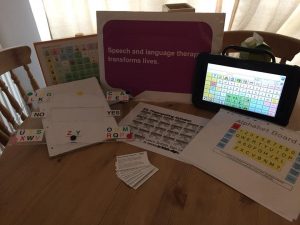Background
Evidence Based Practice (EBP) is now a crucial component of the practice of all speech and language therapists (SLTs). It is essential that all SLTs possess the skills necessary to formulate clinical questions, find and evaluate the evidence and integrate it appropriately into their clinical practice. Here at Newcastle University we offer the first Masters degree in EBP in communication disorders. We have also embedded EBP into the pre-registration degree programmes so that graduates have a range of skills that they can apply to any case they may come across in their clinical practice.
The EBP strand in the Speech and Language Sciences curriculum arose from a joint initiative in 2005 by three members of staff to provide a strong link between taught clinical academic and research modules (reported in Klee, Stringer, & Howard, 2009). Use of the evidence base was well established throughout all teaching, but not all students were demonstrating transfer of research into their clinical academic work or their clinical practice. The aim of explicit EBP teaching was to support students in this aspect of knowledge transfer.
The first steps were to introduce to the BSc programme a final year option module in Principles of EBP and an EBP question into a third year clinical case report. For MSc students a half day EBP workshop was delivered towards the end of their first semester as part of their taught clinical module. Subsequently, skills related to EBP have been introduced at earlier and earlier stages in both programmes following feedback from students. A series of standalone lectures/seminars in induction week for different stages and the final year EBP option have now been replaced by strategically placed lectures and joined up teaching across research and clinical academic modules as described below.
EBP for all students
There is an extensive online EBP resource on Blackboard (the virtual learning environment) available to all students and staff in speech and language sciences (includes CPD and post-registration masters and PhD students). This includes links to websites, critical appraisal checklists, research guidance and other related resources. Students are encouraged to take resources with them for use in clinical practice when they graduate. Email support is available to graduates as they move into work to support integration of EBP into their clinical practice.
Critical use of evidence is integrated into all assessment marking criteria (as appropriate) across all programmes. The requirement for students to demonstrate ability to critically appraise evidence and link it to the theoretical basis of assessment and intervention is assessed with the demand increasing as they progress through the programme.
EBP in the BSc Speech and Language Sciences Curriculum
Stage One
In the first year, principles of EBP are explicitly taught as part of the Speech & Language Pathology I module. This module is taught in the second part of semester two and comprises two Problem Based Learning (PBL) components covering both an adult acquired and a developmental case. The EBP strand is introduced as part of Developmental Speech Difficulties I by way of a short lecture followed by group work. Students are given pre-reading comprising a paper about intervention for phonological awareness. The lecture introduces students to the three basic components of EBP; to the hierarchy of evidence; to critical appraisal and the link to research methods and statistics teaching is made explicit. As a resource they are given copies of the RCSLT Bulletin EBP tutorials that will help them understand the professional and practice context of EBP (Stringer, 2010a, 2010b, 2010c, 2010d, 2010e, 2010f, 2010g). The group work comprises completion of a bespoke critical appraisal checklist in the form of an online wiki. This format allows them to contribute as a group and individually and to access work by all groups.
Stage Two
In the second year students are encouraged to apply their knowledge of research methods and statistics to a broader range of intervention studies. In Speech & Language Pathology II PBL Cases module, students use the bespoke critical appraisal checklist for intervention studies as a basis for critical evaluation of interventions for a total of eight clinical areas (four adult acquired and four developmental speech and language difficulties). During their clinical placements (in house clinics) students are supported to explicitly link evidence and theory to the interventions they are using.
Stage Three
At this stage, there is an implicit expectation in all modules that students will be critically using the evidence base. In Research Methods in Practice III students are introduced to a broader range of research methodologies building on their knowledge of quantitative methods and introducing qualitative methods, mixed methods and surveys and questionnaires. They are given extensive practice in critical appraisal of studies using different methodologies and at different levels of the hierarchy of evidence. They are also given practice formulating research questions arising out of practice-type questions (compared to clinical questions). As a component of their clinical placement assessment, students are required to write a case report about one of their clients, with explicit reference to the evidence base for their intervention and/or assessment.
Stage Four
The demand for evidential support is now explicit for all students in all aspect of their academic and clinical work. This includes: use of evidence based interventions in clinical practice; exploration of the evidence base in the Advance Clinical Practice options modules; linking the evidence base to policy, legislation and practice in the Professional Issues module. Demonstration of critical appraisal skills is required in the literature review of the students’ research project dissertations. Students are given additional opportunity to practice writing EBP (PICO) questions and information that will support them to be EBP champions in their first clinical post as a newly qualified practitioner.
EBP in the MSc Language Pathology Curriculum
Stage One
Prior to the start of module teaching, students are introduced to the principles of EBP in a one day workshop focussing on an introduction to Developmental Speech Difficulties. Students are introduced to the three basic components of EBP; to the hierarchy of evidence and to critical appraisal. In small groups they are required to critically appraise an intervention study and create a resource for the whole cohort. In the MSc Speech & Language Pathology I PBL Cases module, students use the bespoke critical appraisal checklist for intervention studies as a basis for critical evaluation of interventions for a total of eight clinical areas (four adult acquired and four developmental speech and language difficulties). During their first clinical placement (in house clinic) students are supported to explicitly link evidence and theory to the interventions they are using. This is extended into their first external clinical placement.
Stage Two
Students are now expected to be critically using the evidence base as appropriate in all modules. They are required to demonstrate the links between the evidence base and policy, legislation and practice in the MSc Clinical and Professional Education module. At this stage, students are required to undertake a clinical placement focussing intensively on one client; this is written up as their master’s thesis Extended Case Report. It expected that the assessment, intervention and subsequent analysis will be evidence based.
Future considerations
The integration of EBP into clinical academic and research modules is possibly at an optimum level now for students to be confident and skilled in their access and use of the evidence base underpinning Speech and Language Therapy practice after they graduate. However, it is continually monitored and modified in response to student and staff feedback to ensure at each stage that our students are adequately and appropriately skilled in this area.
Students are increasingly questioning the evidence base of interventions they are observing while on clinical placements. They are aware that this can be sensitive. Some of these observations arise due to commissioned work patterns or to the demands of the organisation over riding clinical decision making e.g. a set number of sessions per client regardless of clinical need; clinic-based rather than school-based intervention. It is necessary for students to be equipped and supported to engage in productive discussion with their clinical educators (CEs) about the evidence base of interventions, without them feeling at risk when it comes to their placement assessment. Clinical educators should also be prepared to explicitly engage in evidence discussions with students and require students to demonstrate the evidence base of their assessment and intervention. Newcastle University Speech and Language Sciences staff support students and CEs in this conversation through training provided at the University (e.g. CE training) and throughout the region.
Helen Stringer
References
Klee, T., Stringer, H., & Howard, D. (2009). Teaching evidence-based practice to speech and language therapy students in the United Kingdom. Evidence-Based Communication Assessment and Intervention, 3(4), 195 – 207. doi: 10.1080/17489530903399103
Stringer, H. (2010a). Changing Practice. RCSLT Bulletin, 673, 28.
Stringer, H. (2010b). Evaluating the Written Evidence. RCSLT Bulletin, 672, 22.
Stringer, H. (2010c). Evidence Based Practice in Action. RCSLT Bulletin, 674, 21-22.
Stringer, H. (2010d). Formulating Evidence Based Practice Questions. RCSLT Bulletin, 670, 22.
Stringer, H. (2010e). From the Research Strategy to Practice. RCSLT Bulletin, 698, 22.
Stringer, H. (2010f). Searching for Evidence. RCSLT Bulletin, 671, 22.
Stringer, H. (2010g). What is Evidence Based Practice? RCSLT Bulletin, 699, 22.

